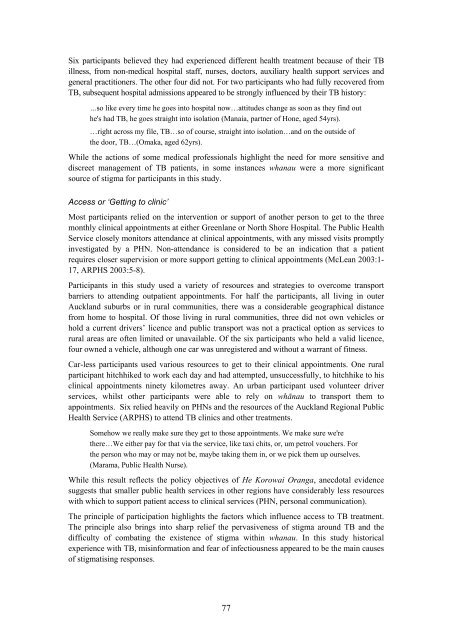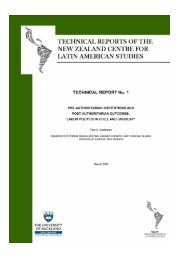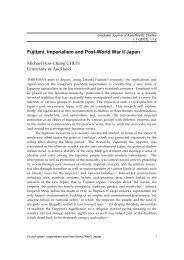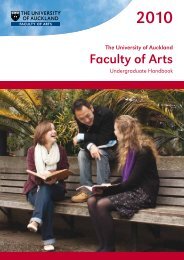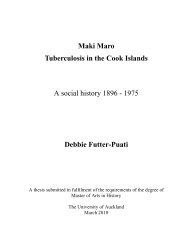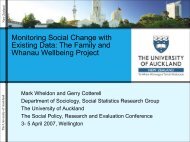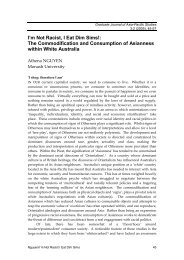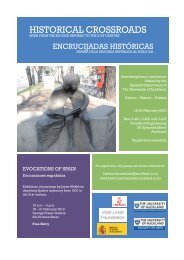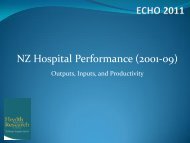Multiplying and Dividing - The University of Auckland
Multiplying and Dividing - The University of Auckland
Multiplying and Dividing - The University of Auckland
Create successful ePaper yourself
Turn your PDF publications into a flip-book with our unique Google optimized e-Paper software.
Six participants believed they had experienced different health treatment because <strong>of</strong> their TBillness, from non-medical hospital staff, nurses, doctors, auxiliary health support services <strong>and</strong>general practitioners. <strong>The</strong> other four did not. For two participants who had fully recovered fromTB, subsequent hospital admissions appeared to be strongly influenced by their TB history:…so like every time he goes into hospital now…attitudes change as soon as they find outhe's had TB, he goes straight into isolation (Manaia, partner <strong>of</strong> Hone, aged 54yrs).…right across my file, TB…so <strong>of</strong> course, straight into isolation…<strong>and</strong> on the outside <strong>of</strong>the door, TB…(Omaka, aged 62yrs).While the actions <strong>of</strong> some medical pr<strong>of</strong>essionals highlight the need for more sensitive <strong>and</strong>discreet management <strong>of</strong> TB patients, in some instances whanau were a more significantsource <strong>of</strong> stigma for participants in this study.Access or ‘Getting to clinic’Most participants relied on the intervention or support <strong>of</strong> another person to get to the threemonthly clinical appointments at either Greenlane or North Shore Hospital. <strong>The</strong> Public HealthService closely monitors attendance at clinical appointments, with any missed visits promptlyinvestigated by a PHN. Non-attendance is considered to be an indication that a patientrequires closer supervision or more support getting to clinical appointments (McLean 2003:1-17, ARPHS 2003:5-8).Participants in this study used a variety <strong>of</strong> resources <strong>and</strong> strategies to overcome transportbarriers to attending outpatient appointments. For half the participants, all living in outerAuckl<strong>and</strong> suburbs or in rural communities, there was a considerable geographical distancefrom home to hospital. Of those living in rural communities, three did not own vehicles orhold a current drivers’ licence <strong>and</strong> public transport was not a practical option as services torural areas are <strong>of</strong>ten limited or unavailable. Of the six participants who held a valid licence,four owned a vehicle, although one car was unregistered <strong>and</strong> without a warrant <strong>of</strong> fitness.Car-less participants used various resources to get to their clinical appointments. One ruralparticipant hitchhiked to work each day <strong>and</strong> had attempted, unsuccessfully, to hitchhike to hisclinical appointments ninety kilometres away. An urban participant used volunteer driverservices, whilst other participants were able to rely on whānau to transport them toappointments. Six relied heavily on PHNs <strong>and</strong> the resources <strong>of</strong> the Auckl<strong>and</strong> Regional PublicHealth Service (ARPHS) to attend TB clinics <strong>and</strong> other treatments.Somehow we really make sure they get to those appointments. We make sure we'rethere…We either pay for that via the service, like taxi chits, or, um petrol vouchers. Forthe person who may or may not be, maybe taking them in, or we pick them up ourselves.(Marama, Public Health Nurse).While this result reflects the policy objectives <strong>of</strong> He Korowai Oranga, anecdotal evidencesuggests that smaller public health services in other regions have considerably less resourceswith which to support patient access to clinical services (PHN, personal communication).<strong>The</strong> principle <strong>of</strong> participation highlights the factors which influence access to TB treatment.<strong>The</strong> principle also brings into sharp relief the pervasiveness <strong>of</strong> stigma around TB <strong>and</strong> thedifficulty <strong>of</strong> combating the existence <strong>of</strong> stigma within whanau. In this study historicalexperience with TB, misinformation <strong>and</strong> fear <strong>of</strong> infectiousness appeared to be the main causes<strong>of</strong> stigmatising responses.77


